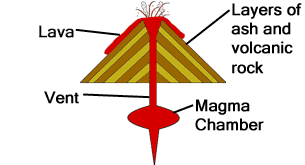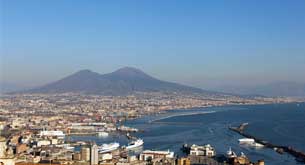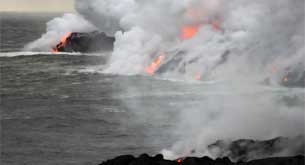Facts about Volcanoes
Posted by Allen Douglas / in Science Facts
The Earth's surface is made up of soil, water and bedrock. Under the bedrock are layers of solid rock called the earth's crust. The crust has cracks called faults. The pieces of rock in the crust are called plates. The rock plates move slowly over a layer in the Earth called magma. Magma is hot melted rock. The magma can pass through the faults in the bedrock and other weak spots. When magma moves up into the bedrock and soil it runs into water which turns to steam (water vapor). Water vapor builds up pressure underground with the rising magma. When the magma reaches the surface, scientists call it lava. The pressure of the magma and water vapor under the surface can cause a volcano to explode into the sky. When a volcano explodes with a high amount of pressure, it can spread many tons of volcanic ash miles and miles around the area of the eruption.

Parts of a volcano
Volcano Facts
- Volcanoes are found above locations of conveying and diverging bedrock plates and above hot spots in the Earth.
- There are 3 shapes that scientists group each volcano into, including cinder-cone volcanoes, shield volcanoes and composite-cone volcanoes.
- Cinder-cone volcanoes have a shape that has very steep sides. Many cinder-cone volcanoes are small.
- Shield volcanoes include some of the largest volcanoes found on Earth. The shape of a shield volcano has gentle slopes on the sides.
- Composite-cone volcanoes are a mix of shield and cinder-cone. The shape of a composite cone volcano has steep slopes at the top and gentle slopes at the bottom. Mt. Fuji in Japan and Mount Vesuvius in Italy are good examples of composite-cone volcanoes.
- The depression at the top of the volcano is known as the crater.
- Craters are sometimes quite large. The largest volcanic crater is located on a volcano called Mount Aso in Japan. Mount Aso has a crater with a circumference of 71 miles (114 km).
- The highest active volcano is Volcan Antofalla at 21,161 feet (6450 meters) above sea level. Volcan Antofalla is located in Argentina.
- The highest dormant volcano is Volcan Llullaillaco at 22,057 feet (6723 meters) above sea level. It is located between Argentina and Chile in South America.
- The highest volcano in the world is Cerro Aconcagua in Argentina at a height of 22,834 feet (6960 meters) above sea level. It is an extinct volcano.
- The largest volcano on Earth is Mouna Loa on the Island of Hawaii. Mouna Loa is actually taller than Mt Everest! The part we can see is 13,448 feet (4100 meters) above sea level, but the volcano extends all the way to the bottom of the Pacific Ocean which is another 16,400 feet (5000 meters) below water. The big island of Hawaii was formed with Mouna Loa.
- Volcano eruptions have an effect on the weather. In 1815 a volcano known as Mount Tambora erupted, discharging billions of tons of ash into the atmosphere. In 1816 many places in the world experienced very cold weather. Six inches of snow fell in many of the Northeastern United States in June of 1816.

The volcano Mount Vesuviua towers over the city of Naples in Italy

Active lava flow into the Pacific Ocean in Hawaii
